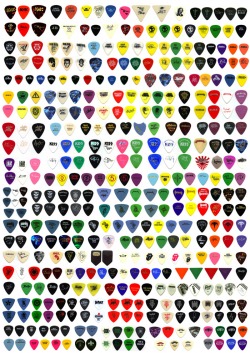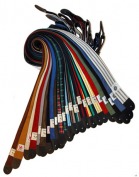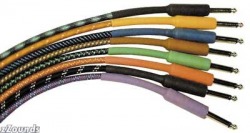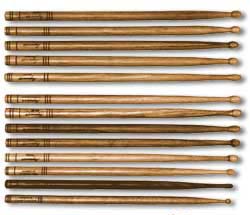//////////////////////////////////////// a comprehensive guide on how to rock
ESSENTIALS
PICKS

What type of pick you use is really a matter of personal taste. Some guitarists prefer thicker picks while others prefer the sound of a thinner pick. It's really up to you. When starting out, you may want to drop into a music store and grab a few different sizes and thickness to see what feels & sounds best for you.
As a basic recommendation, however, I would try out a standard, medium gauge [thickness] pick. These tend to sound best for both picking & strumming & tend to feel the most comfortable.
Regardless of your pick selection, you will also want to select a pick that isn't too smooth. If the pick is too smooth it's likely to slip around a lot - leaving you with no control.
STRAPS

Now, while I've used things like luggage straps for makeshift guitar straps before, it's certainly not a technique I would recommend.
When selecting a strap you want to make sure that the length is not too long or short. A strap that is too short leaves you with an instrument up to your chin; a strap that is too long leaves you looking like an ape hunched over...whatever it is apes eat. Bananas or something.
The next step is to make sure the ends are made of a material that will not bend, break, or stretch out too quickly. A little give is needed so that you can get your strap pins into the strap but too much could mean your instrument falling to the ground.
CORDS

Selecting an instrument cable is important if you wish to play an amplified instrument like an electric guitar or bass. Cords are a fairly basic essential and there are only two basic things to really consider when selecting an instrument cable: length and types of input.
Most amplifiers have a 1/4 inch input so you want to make sure the cable you select features this size plug. Aside from this the choice is really up to you. Most musicians prefer at least a 10" cable so that they are not glued to their amp. Most instrument cables also come in longer sizes like 15" and 20" feet as well.
If you do not plan on using the cable for live performance or do not plan on ever needing ten feet of space from your amp - then you may choose from shorter distances - 3", 6", 8", etc.
Another feature you may want to look into is whether or not you like straight or angled plugs. An angled plug cable will have one end with a straight plug and another end that features a plug that is bent at a right angle. This usually comes in handy if you prefer having the cable dangle down the amp rather than come straight out.
STICKS

A drummer's best friend. Not having the right pair of sticks can be the quickest way to not only a sound you aren't happy with, but hands that aren't too happy with your selection either.
Selecting your drumsticks may be more involved than you think. First off, what type of band will you
be playing in primarily? This helps determine the right drumsticks for you. The harder you play, the beefier the stick you need to absorb the shock and abuse they will receive. If you're playing in a quieter setting, smaller/lighter drumsticks give you just that right touch. This will help you select the correct size. For instance, for a heavy metal band, you'll need thicker drumsticks to withstand the heavy abuse they will take. Larger drumsticks are normally a 5B or 2B size (2B is larger) and will usually last much longer than thinner sticks. If you play in a jazz/pop/rock band, you will want to go with a smaller stick. Either a 7A (thin, my personal favorite) or a 5A (standard) will suffice. Of course, if you play many styles, you may find that a 5B is the most suited for you because a 5B drumstick is versatile.
When you get ready to purchase new drumsticks from a store, it is important to roll them. Do this by putting them on a flat countertop and gently rolling them. If they wobble, you may want to select another pair. While a slight wobble won't really hurt anything,
you will notice the feel of greatly warped drumsticks in your hand.
Although all of these things are important when selecting a pair of drumsticks, the ultimate question is do they feel good? This is one of the most important questions about drumsticks and probably one of the main determiners in how drummers go about buying drumsticks. Ultimately, we want them to feel good in our hands. Drumsticks become a part of us when we play. They are an extension of your limbs and they much "feel" right or we won't be comfortable behind the drums.
If you sweat a lot, you may want to buy drumsticks that don't have a slippery coating on them. Drummers that sweat profusely tend to even sand their sticks down with sandpaper so that it helps them get a better grip. Otherwise, varnished sticks not only look good but they tend to give the average drummer a nice subtle gripping feel.
